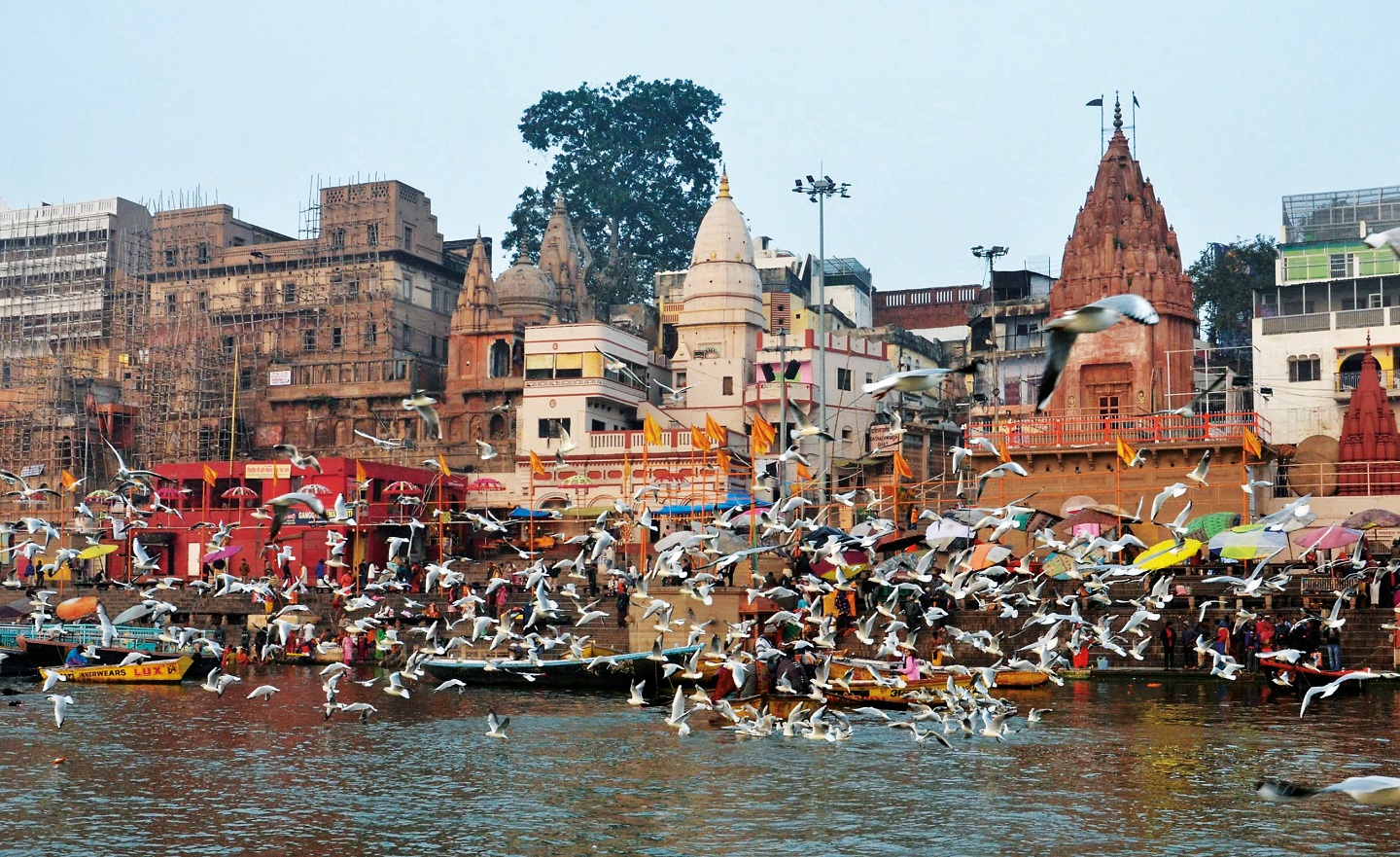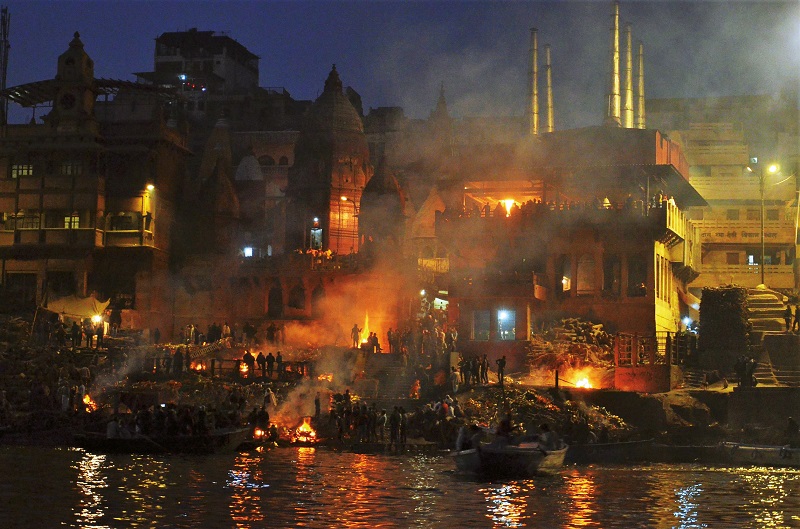
A flock of birds flies low over the Ganges river in front of the ghats in the morning (All photos: Lee Yu Kit)
Varanasi, Benares or Kashi, as it was once known, is unrelentingly chaotic, a discordant orchestra of vehicles honking and beeping, cows wandering indolently on traffic-choked streets, stray dogs flirting dangerously with passing vehicles and motorcyclists darting into the narrowest of openings in the give-no-quarters traffic.
A thin layer of dust coats everything, dulling the sheen of green foliage, and imparting a look of dim fatigue to the city, despite its energetic tumult. Comprising the New and Old City, the chaos is magnified in the narrow streets of the latter, one of the oldest in this ancient country, although raids by marauders and invaders, and the destruction of Hindu temples by the Mughal emperor Aurangzeb in the 17th century, destroyed most of what was once truly ancient.
The traffic skirts the maze of narrow alleyways that thread through parts of the old city, urban ravines with paths wide enough only for small motorcycles, bicycles and pedestrians. It’s cool and relatively quiet away from the deafening din of traffic, with corner tea stalls, altars and small shops squeezed into narrow niches. The city ends suddenly and gracefully. There’s the shimmer and the shine and vast silvery expanse of the sky and the mother river, the Ganges.
The Ganges is one of the world’s great rivers, rising in the icy Himalayas and joined by numerous tributaries as it traverses the vast plains and cities of the subcontinent. It is known as the Hooghly and the Padma, and as the Ganges where the great curve of the river pushes against the ghats on the left bank at Varanasi.
logs.jpg

This is the holiest of Indian cities, where devotees in their millions come to give thanks, to celebrate life, to cleanse themselves of bad karma, and for some, to take up residence in hospices where they hope to end their lives so they can be cremated on the banks of the mother river.
The river, which nourishes and nurtures life with its waters for irrigation, drinking, washing and a dozen other uses, shows its dark side during the annual monsoon season from July to September, when it swells into a monstrous force, irresistible and terrible, sweeping away anything in its path.
Some of the buildings on the ghats have high-water marks on their walls, marking the height of its destructive power. In 1978, the flood swelled beyond the ghats, semi-submerging many of the buildings in the timeless cycle of life and death, of becoming and dying.
There are 85 ghats, a series of broad concrete steps that lead to the water’s edge. Two of these are cremation ghats, the smaller one at Harishchandra Ghat and the larger one at Manikarnika Ghat.
A forest of trees makes its way to the cremation ghats every day, logs on barges and in stacks piled many feet high. In the night, the funeral pyres burn brightly, the liberating flames leaping into the dark sky with a roar. Electric furnaces are available, but traditional wood pyres are preferred most of the time.
manikarnika.jpg

Every evening, at dusk, the Aarti, or the Fire Puja, is performed at the edge of the river. Priests clad in ceremonial garb of red tunic with shimmering sashes carry out the ritual worship of Lord Shiva and of the Ganges. Fire is a major element in the hour-long ceremony, wielded by the priests who chant and sing, and describe the circular symbol of “Om” with goblets of fire and incense and blow conch shell horns, building to a crescendo in the elaborately scripted ritual.
Spectators in their thousands crowd around the raised platforms, rapt in the sounds of chants and music from speakers. They chant, stand and clap in unison as the ceremony draws to a close, the faithful gathering around the priests to receive blessings, while boats carrying spectators are locked in a phalanx bobbing in the river beside the ghat.
There are several parallel Aarti ceremonies held on the ghats. Two are carried out at the main Dashashwamedh Ghat, with another set held simultaneously at Assi Ghat, where the line of ghats begins.
At night, the ghats are brightly lit by floodlights, the buildings backlit by coloured lights that change colours, bathing the buildings in a soft glow that contrasts with their harsh stony appearance in the bright light of day. Beyond is the darkness of the river, with the occasional sound of boats motoring by, or the slap of wooden oar on water.
Various types of buildings line the ghats. Some are guest houses with the occasional five-star hotel housed in a heritage building, such as the BrijRama Palace, the Suryauday Haveli and the Guleria Kothi Hotel. There are also forbidding, fort-like buildings, seemingly abandoned and crumbling from neglect, pigeons roosting in the watchtowers, plants springing from cracks in the walls and bird droppings scarring the tall stone walls. Some were, and still are, royal residences brought low by the costs of maintenance and the vicissitudes of wealth and power. There are association buildings, such as the House of Naked Sadhus, and dozens of temples, on and directly behind the ghats, in this city of over 22,000 temples.
priest.jpg

The most sacred of these is the Kashi Vishwanath temple, called the golden temple of Varanasi for its gilded domes, built with gold supplied by Maharaja Ranjit Singh in 1835. The temple is one of the holiest places of worship in the Hindu religion, with devotees queueing for hours to days to enter its premises. According to Hindu legend, it is one of the 12 Jyotirlingas, where Lord Shiva’s light pierced the Earth when he was mediating a dispute between the deities Lord Brahma and Lord Vishnu.
Construction of the Narendra Modi-initiated temple corridor is underway. When completed, the corridor will provide access to the Kashi Vishwanath temple from the ghats. In the process, numerous residences have been demolished, exposing old temples once hidden in the maze of buildings, and more controversially, the Gyanvapi Mosque.
The Gyanvapi Mosque was built by Emperor Aurangzeb in the 17th century. It was erected over an earlier Hindu temple demolished by Aurangzeb, said to be the spot of the Jyotirlinga, with the Kashi Vishwanath temple built adjacent to it.
Against this backdrop, the area is ringed in tight security, with body-armoured, rifle-wielding soldiers standing in barricaded positions as security against communal tensions.
The ghats form a continuous line from one end to the other, so that it is possible to walk their entire length, taking in the panoply of life and death.
boating.jpg

Devotees bathe in the river at all hours of the day and into the night, surrendering themselves to the flow of the mother river to cleanse themselves of accumulated bad karma. People do their laundry in the river, fish in it, lovers clasp hands and look longingly at each other by the river, wedding parties with bride and groom bedecked in jewellery and clothed in red and gold raiment, accompanied by a lusty small band, descend to the river and dance on the ghats. Boatmen accost visitors every few metres with the query “Boat?” followed by “very good price” and “now good time for boat ride”. Men offer massage services by the river. There’s an endless choice of snacks and fresh masala chai.
Cows ply the ghats. There are many stray dogs, sleeping on the pavement, birthing a generation of cute, frisky puppies destined to a life in the outdoors and the fickle charity of humans. Monkeys prowl parts of the ghats, making their presence felt in the mornings with raids on nearby residences and hotels. They are revered as symbols of the deity Hanuman. Colourful swathes of laundry hang on lines or are laid out to dry on the ghats. Boats, turned on their sides, are repaired and painted.
For all the activity, the ghats are clean. Cleaning efforts by non-governmental organisations and the government make walking along them anxiety-free, with hardly any litter to be seen, and big garbage bins placed along the way.
This cleanliness extends to the river itself, with the occasional clump of garbage at the water’s edge being the exception rather than the rule. Locals concur that the clean-up efforts, from several years ago, have made a vast difference to the environment.
A boat ride on the river is the thing to do, the mood of the river shifting in the course of the day and with the season. On wintry mornings, a low mist hangs over the surface of the water. Ghostly shapes emerge and flocks of birds swoop noisily over the boats, drawn by packets of bird food sold by vendors to tourists in boats.
In the evenings, the mood of the river changes in the crepuscular light. Lights begin to flicker on, reflected in evanescent patterns on the water. The sky blushes a pale pink, then darkens. Points of floating lights are small bouquets of flowers and candles set adrift by visitors with a silent wish and a sigh.
The mother river flows as it always has since time immemorial, following its own timeless rhythm, birthing life, nourishing it and embracing death.
This article first appeared on Feb 13, 2023 in The Edge Malaysia.


